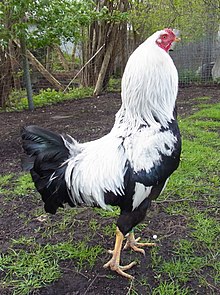Kraienkopp
The Kraienkopp is a pedigree chicken with defined standards. Kraienköppe do not count as fighting fowl, but are closely related to them. They look more like a mix of Italians and country fowls with a fighter touch. There is also a dwarf form, the dwarf Kraienkopp .
Confusing naming
In Dutch, the breed is called Kraienkopp "Twents hoen". The Dutch chicken breed "Kraaikop", on the other hand, is called " Breda " in German .
History of the breed and the special association
The start of the breeding of this breed lies in the German-Dutch border area in the province of Twente . Around Enschede , Ahaus and the Grafschaft Bentheim , where most of the breeds can still be found today, the breed originated on both sides of the border. Breeding was promoted in the Netherlands in particular by the Lazonder brothers between 1880 and 1890 and exhibited the breed there for the first time in 1885. They were named Twentse Grijze there . In Germany this name could not prevail, in this country they have been called Kraienköppe or dwarf Kraienköppe since then.
The starting breeds for breeding the Kraienköppe were: Malay , Belgian fighters , Italians and various Dutch country chickens .
In Germany they were exhibited for the first time at a larger show, the "German Young Poultry Show" in Hanover in 1925. The new breed received general recognition from the breeders of poultry, and the animals have now been shown at all leading poultry shows in Germany. In 1926 the breed was included in the "German Poultry Standard". Thereupon the special association of the Kraienköppe was founded in 1932 in Essen. As a result of the Second World War, club life almost came to a standstill.
After the end of the war, the Kraienköppe breeders met on November 28, 1948 in western Germany at the state poultry show in Düsseldorf and revived the special association. Poultry breeders began to organize in the GDR as well. On December 11, 1949, the special breeding association of Kraienköppe and Dwarf Kraienköppe was founded in Erfurt.
When Germany was reunified in 1990 , the breed poultry breeders' organizations were also united. The Kraienkopp breeders from the new federal states founded a group Mitte and joined the special association in 1990.
At the European Show 2012 in Leipzig , for the first time, large Kraienköppe in white and gold necked (red saddled) stood for recognition. These animals received an excellent evaluation by the Federal Breeding Committee and were also recognized at the first presentation.
Properties, existence, color variations
Kraienköppe has a strong stature with rich tail plumage and a distinctive broad shoulder. The roosters in particular have lush neck plumage and a distinctive, characteristic neck. The red ear lobes and wattles are only slightly developed and the comb consists of a small bulge in the shape of an elongated strawberry. In the hens, the comb is flat and the small wattles are barely visible. The animals are therefore very hardy, have a very good laying performance and lay a sufficient number of eggs even in the heaviest frost. The animals are very happy and resilient. In Germany, the Kraienköppe in the colors silver-necked, gold-necked, orange-necked, blue-gold-necked and red-saddled are permitted. Kraienköppe are considered to be an easy-care poultry breed with very good economic benefits.
Standard cocks weigh 2.5 to 3 kg, hens 1.75 to 2.5 kg. The laying capacity in the first year is around 200 eggs. The minimum weight for hatching eggs is 55 g.
Kraienköppe are considered to be a chicken breed with distribution among purebred poultry breeders far beyond their traditional breeding area.
Web links
Footnotes
- ↑ a b Brief description of the Kraienköppe. In: kraienkoeppe.de. Special association of breeders of Kraienköppe and dwarf Kraienköppe, accessed on November 3, 2014 .
- ↑ a b Wilfried Detering: Fighters and dwarf fighters of the world . 2nd, completely revised edition. Oertel + Spörer, Reutlingen 2004, ISBN 3-88627-520-5 , Kraienköppe (Twentse Grijzen), p. 103-105 .
- ↑ Brief description of the dwarf Kraienköppe. In: kraienkoeppe.de. Special association of breeders of Kraienköppe and dwarf Kraienköppe, accessed on November 3, 2014 .
- ↑ Wilfried Detering: Fighters and dwarf fighters of the world . 2nd, completely revised edition. Oertel + Spörer, Reutlingen 2004, ISBN 3-88627-520-5 , Zwerg-Kraienköppe, p. 105-107 .
- ↑ The club's history. In: kraienkoeppe.de. Special association of breeders of Kraienköppe and dwarf Kraienköppe, accessed on November 3, 2014 .
- ↑ Walter Schwarz, Armin Six: Chickens, turkeys, guinea fowl (= The great poultry standard in color . Volume 1 ). 7th revised and expanded edition. Oertel + Spörer, Reutlingen 2004, ISBN 3-88627-511-6 , Kraienköppe, p. 163-165 .
